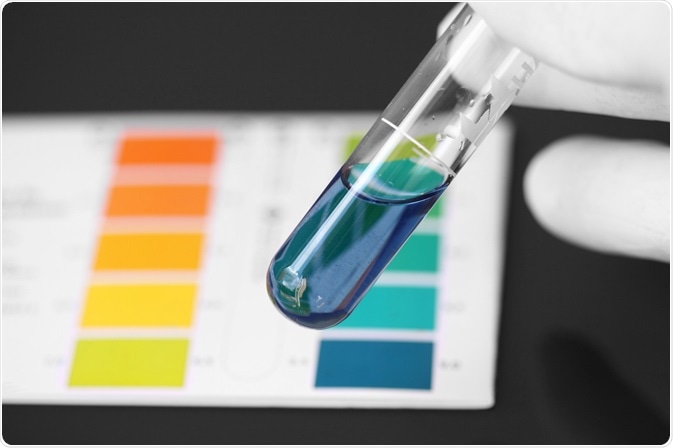A pH meter measures a pH or the acidity/alkalinity of substances. Most pH meters rely on a glass electrode that measures the number of hydrogen ions in the solution. Usually, pH meters need to be calibrated every day or week.
 Image Credit: rigsbyphoto / Shutterstock
Image Credit: rigsbyphoto / Shutterstock
Temperature correction
This a critical step in calibrating the pH meter, as pH varies with temperature. Some pH meters have in built temperature measurement probes, while in other cases an external temperature probe may be required.
Using external or internal measurements, the temperature values will need to be fed into the pH meter. It should be noted that the temperature of the buffer pH can also result in changes in pH.
Preparation of calibration buffer
Around 30 mL solutions of three different calibration buffer solutions are used – one at pH 10.00, another at pH 7.00, and the third at pH 4.01.
After pouring these solutions in to 50 mL beakers, they can be covered with a watch glass or a parafilm before the process of calibration. The temperature of all these buffers should be the same, as the pH values are temperature dependent.
Sample preparation
The sample solution can be prepared based on requisite requirements. Then, 30 mL of this solution can be poured in to a 50 mL beaker. This solution should also reach the same temperature as the calibration buffers as pH varies with temperature, as mentioned above.
Preparation of electrode and meter
The electrode and meter can be prepared and set up based on the user guide as these conditions may vary based on each instrument and company.
Calibration method
All the buffers should reach the same temperature before the calibration process. Temperature compensation can be done if the temperature of the buffers is not 25°C. The temperature of the buffers can be manually calculated using a thermometer and the values can be manually added to the meter to convey the values to the pH meter.
The calibration buffers, prepared as previously described, can be uncovered. The pH electrode should be carefully rinsed in deionized water to avoid contamination of the buffers. It should be noted that the pH electrode should never be washed with the same buffer that will be subsequently used for calibration.
First, the pH electrode can be kept in the calibration buffer at pH 10.01 such that the electrode tip and junction are completely immersed in the calibration buffer. After starting the calibration on the meter, it is preferable to wait for 1-2 min, till the reading on the meter has stabilized.
If the temperature of the buffer is not automatically recognized, then the value should be manually entered to obtain the temperature, and thus the correct pH value. After this is done, then the electrode should be rinsed with deionized water before calibrating with the next buffer to prevent contamination.
The electrode can now be placed in the pH 7.00 calibration buffer. After waiting for the stable reading for 1-2 minutes, the temperature corrected reading can be recorded.
If the temperature values are not automatically detected then the values will have to be added manually to get the appropriate readings. Electrode should be rinsed with deionized water again after performing the calibration to avoid contamination at the next step.
The electrode can now be placed in the pH 4.01 calibration buffer. The reading should be allowed to stabilize for 1-2 minutes before recording. Again, the temperature values can be manually entered if it is not detected automatically, and the electrode should be rinsed with deionized water.
Sample measurement
The samples should all be at same temperature as the calibration buffers, as the pH readings are dependent on temperature as stated above. If the samples are not at 25°C, then temperature corrections can be performed.
The samples can be appropriately prepared, and the electrode should be washed with deionized water. Subsequently, the reading can be started. After the electrode is placed in the sample solution, the sample can be gently stirred at a steady and moderate rate.
After waiting for the reading to stabilize for 1-2 minutes, the reading can be recorded. These steps can be repeated if required. Before each reading, the electrode should be rinsed with deionized water.
Sources:
- https://static.thermoscientific.com/images/D16807~.pdf
- http://chemed.chem.purdue.edu/genchem/lab/equipment/phmeter/use.html
- https://sciencing.com/calibrate-ph-meter-4796148.html
Further Reading
- All pH Content
- pH in the Human Body
- Factors Affecting pH Meter Accuracy
- Health Benefits of Alkaline Water
- What Makes Something Acidic or Alkaline?
Last Updated: Oct 22, 2018

Written by
Dr. Surat P
Dr. Surat graduated with a Ph.D. in Cell Biology and Mechanobiology from the Tata Institute of Fundamental Research (Mumbai, India) in 2016. Prior to her Ph.D., Surat studied for a Bachelor of Science (B.Sc.) degree in Zoology, during which she was the recipient of anIndian Academy of SciencesSummer Fellowship to study the proteins involved in AIDs. She produces feature articles on a wide range of topics, such as medical ethics, data manipulation, pseudoscience and superstition, education, and human evolution. She is passionate about science communication and writes articles covering all areas of the life sciences.
Source: Read Full Article
